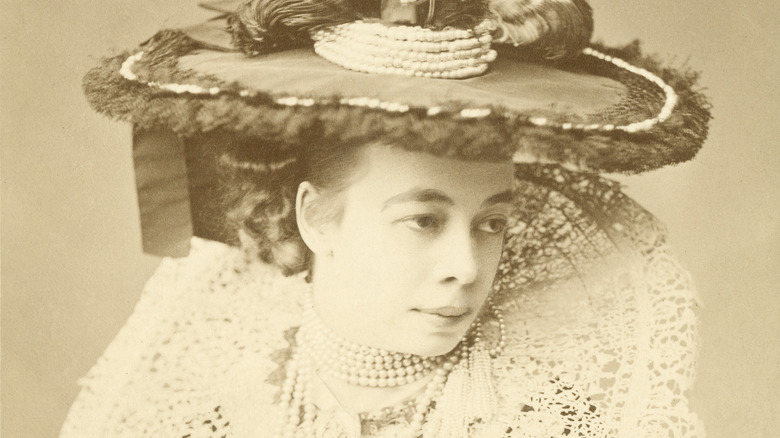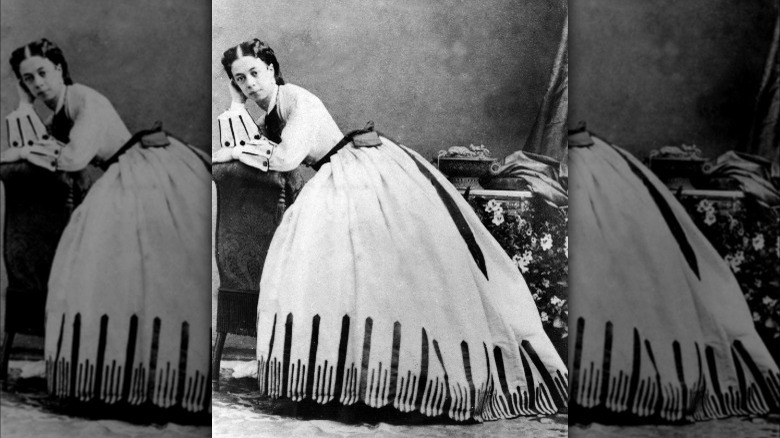The Wild Story Of A Topless Duel Between Two Austrian Noblewomen
In the past, when people had beef with one another, people took up arms — sometimes swords, other times guns — to settle things with a duel. The last known duel to be fought with swords took place in France as late as 1967. Years before that, though, a debatable story suggests that in 1892, a duel took place in Austria between two women: Princess Pauline Metternich and Countess Anastasia Kielmannsegg. Their fight is now known as a petticoat duel, or the first "emancipated duel" in history, Britannica writes. Strangely enough, in this case, the two women squared off while topless.
And what was the issue between the two women? Floral arrangements, it seems, were Kielmannsegg's thing, and the countess took exception to the princess' criticisms of some flower displays she had done for a special event. Rather than talk it over like grownups, the two women decided to take up rapiers against one another. According to 1965's "The Duel: A History of Dueling" by Robert Baldick, at that time it was considered a sign of modernity for women to fight for themselves. Previously, most — but not all — women asked men to duel for them.
The duel was an all-female affair
If at first it seems like a fight to first blood or possibly death over floral arrangements is excessive, keep in mind in the 1820s American senator John Randolph of Virginia and then Secretary of States Henry Clay agreed to duel with pistols because Randolph implied that Clay had "blackleg," a disease affecting cattle. (That duel got called off, according to Boundary Stones). Decades later, the duel between Princess Pauline Metternich (pictured above) and Countess Anastasia Kielmannsegg over flowers was fought with rapiers to first blood.
In the dueling tradition, seconds — "men who accompanied the duelists and negotiated the terms of the duel," according to Boundary Stones — were more than just intermediaries between the two duelists. They were also charged with offering the challenge, accepting or apologizing for whatever slight may have offended the challenging party, and if the former, agreeing on weapons and arranging for a time and place. Presiding over the confrontation between the two members of Austrian high society was Baroness Lubinska. The countess and princess hoped Lubinska — trained in modern medicine for the era — could attend to any wounds incurred through fighting. Lubinska, for example, is said to have supported the use of antiseptics in surgical settings, then a new idea. Eventually, a time and a place were set: August 1892 in the Liechtenstein capital city, Verduz.
A sword fight, clothing optional
On the topic of cleanliness, Baroness Lubinska also recommended the princess and countess fight while topless. The reason being, if someone gets stabbed, bits of cloth from their clothing might get stuck in the wound, which might worsen the odds of infection — good advice. The importance of cleanliness in medical situations had only been introduced some two decades early by Joseph Lister, the namesake of Listerine. And as Hektoen International writes, in the American Civil War, many soldiers died from post-operative infections, especially after an amputation.
With that it was decided that the two Austrian noblewomen would sword fight with no shirts on. For propriety's sake, no men would be around — unless the coachmen were counted, but those men were commanded to stand with their backs to the action. Once fighting commenced, the princess was mildly wounded on her nose, but she then stabbed the countess through the arm. According to the Pall Mall Gazette (via "A Complete Bibliography of Fencing and Duelling"), a London news outlet writing in 1892, the seconds in the duel — Princess Schwartzenberg and Countess Kinskey — called for clearer heads to prevail before things got worse, and the princess was declared the winner.
With ample blood flowing from the two women due to their injuries, there were naturally cries of pain. The attending coachmen could not contain themselves. Rushing to help the women, Baroness Lubinska reportedly said (via The Woman of Action Network), "Avert your eyes, avert your eyes — you lustful wretches!" — ever mindful of Victorian-era decorum, bloody-soaked scene notwithstanding.
Is the story true?
Though the story of the alleged duel between Princess Pauline Metternich and Countess Anastasia Kielmannsegg can be found in various publications, it has also received pushback. According to Jenny Wiltz, Dutch historian Ignaz Matthey noted that Pauline Metternich spoke to a French newspaper about the purported event and denied it ever happened. "The alleged meeting with the sword which would have taken place between Madame de Metternich and the Countess Kielmandsegg [sic] is definitively denied by this dispatch: Esztergom, 22 August, 8 h 40. Stupid and ridiculous canard invented by Italian newspapers," it reportedly read.
Wiltz notes that one paper, Wiener Caricaturen, postulated that the story was satire created by another publication, Viennese Caricatures. The lack of any official accounts and regurgitation of the story across several newspapers suggests that this could be the case, though for now, the accuracy of the story is unknown.
Petticoat duels
It's important to note that some women fought what were known as petticoat duels as early as the 1600s. One story suggests a duel between two women in England took place a century prior to the purported clash between the princess and the countess, when Lady Almeria Braddock crossed smallswords with Mrs. Elphinstone. However, this story is also likely untrue, as it was originally published as a fictitious account in 1792 in Carlton House Magazine.
One duel that appears to have actually happened took place in London in 1723, and it was fought with wooden overshoes. The clash allegedly led to one death. According to All Things Georgian, in December 1723, the London Journal wrote of the affair, "Some Days ago a Female Duel was fought at Greenwich, in which one of the Combatants kill'd her Antagonist with her Patten. The Coroner's Inquest having sate upon the Body of the Deceased, brought in their Verdict Manslaughter."
Still, the alleged duel between the Austrian noblewomen is referred to as the first "emancipated duel" because all the parties involved, including the seconds, were women.




